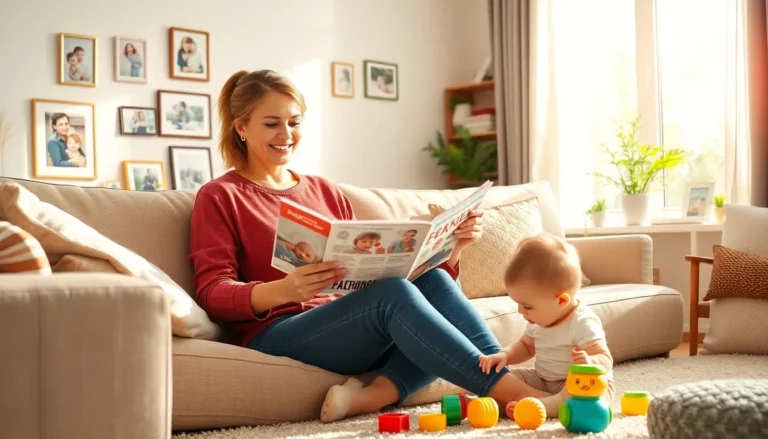Table of Contents
ToggleIn a world that never stops moving, the concept of slow living offers a refreshing escape. It encourages individuals to embrace a more intentional lifestyle, focusing on quality over quantity. By slowing down, people can cultivate deeper connections with themselves, others, and their surroundings.
This mindful approach promotes well-being and creativity, allowing individuals to savor everyday moments. Whether it’s enjoying a leisurely meal or taking the time to appreciate nature, slow living invites a sense of peace and fulfillment. As more people seek balance in their hectic lives, the principles of slow living resonate deeply, providing a pathway to a more enriched existence.
Understanding Slow Living
Slow living embodies a thoughtful alternative to today’s rapid lifestyle. This mindful approach nurtures intentionality and connection with oneself, fostering a deeper appreciation for life’s moments.
Definition of Slow Living
Slow living refers to a lifestyle characterized by a conscious choice to prioritize quality experiences over speed and productivity. It encourages individuals to savor each moment, fostering mindfulness in daily activities such as eating, socializing, and engaging with nature. This philosophy promotes a healthier relationship with time, allowing individuals to engage more deeply in their pursuits and experiences rather than rushing through them.
Core Principles of Slow Living
The core principles of slow living focus on enhancing well-being and promoting sustainable choices. Key elements include:
- Mindfulness: Prioritizing present-moment awareness in every activity. This enhances enjoyment and decreases stress.
- Simplicity: Embracing minimalism by reducing clutter in both physical and mental spaces. This fosters clarity and peace.
- Connection: Cultivating relationships with people and nature. This builds deeper bonds and promotes emotional health.
- Sustainability: Making environmentally friendly choices. This supports a healthier planet and promotes longevity.
- Quality over Quantity: Focusing on high-quality experiences, relationships, and products instead of accumulating excess. This nurtures fulfillment and satisfaction.
These principles combine to support a richer, more meaningful existence, leading to enhanced joy and creativity.
Benefits of Slow Living

Slow living offers numerous advantages that positively influence both individuals and the environment. Adopting this lifestyle can lead to significant improvements in mental health and environmental sustainability.
Mental Health Advantages
Slow living reduces stress by fostering mindfulness and promoting a more harmonious lifestyle. Individuals who embrace this approach often experience improvements in focus and clarity, enabling them to engage deeply with tasks. Quality interactions with family and friends enhance emotional well-being, creating a sense of belonging and support. This lifestyle encourages self-reflection, leading to greater self-acceptance and resilience against daily challenges.
Environmental Impact
Slow living emphasizes sustainability, resulting in a positive impact on the environment. By prioritizing quality over quantity, individuals tend to consume less, reducing waste and resource depletion. Supporting local businesses strengthens community ties and minimizes carbon footprints associated with long-distance transportation. Engaging in activities like gardening or mindful eating fosters a deeper appreciation for nature, encouraging sustainable practices and promoting environmental awareness.
How to Embrace Slow Living
Embracing slow living requires intentional choices that enhance one’s well-being and foster deeper connections. Here are practical strategies to incorporate this lifestyle into daily life.
Practicing Mindfulness
Practicing mindfulness serves as a cornerstone of slow living. Engaging fully in the present moment cultivates awareness and enhances experiences. Focus on sensory details when eating or walking. For instance, savor each bite of food or notice the colors and sounds around during a stroll. Techniques like meditation, deep-breathing exercises, and journaling promote this mindfulness approach. Taking breaks from technology allows for greater reflection and reduces distractions, significantly enhancing mental clarity and emotional regulation.
Creating a Slow Living Space
Creating a slow living space involves curating an environment that promotes tranquility and simplicity. Decluttering living areas encourages a sense of calm, making it easier to focus on meaningful activities. Use natural lighting and incorporate plants, which improve air quality and foster connection with nature. Select minimalistic furniture and decor to reflect simplicity and functionality. Design cozy corners for reading or relaxing, fostering an atmosphere that encourages slower, more deliberate living routines. This intentional arrangement serves as a physical reminder to embrace a slower pace in life.
Challenges of Slow Living
Slow living faces various challenges that individuals encounter while trying to adopt a more intentional lifestyle. These challenges often stem from societal norms and personal habits that conflict with the principles of slowing down.
Modern Society Pressures
Modern society promotes constant activity and productivity, leading to a culture that values speed over quality. Individuals often feel pressured to meet societal expectations, such as maintaining a busy schedule or achieving rapid success. This relentless pace creates stress and diverts focus from meaningful experiences. Many find it difficult to resist the urge to conform to these norms, which can hinder their ability to embrace slow living fully. Additionally, social media can amplify these pressures, showcasing curated, fast-paced lifestyles that challenge one’s commitment to simplicity and mindfulness.
Overcoming Obstacles
Overcoming obstacles to slow living requires strategic changes in mindset and behavior. Individuals can start by setting clear intentions, prioritizing activities aligned with their values, and gradually reducing commitments. Practicing self-compassion fosters patience during this transition, allowing individuals to embrace slow living at their own pace. Establishing boundaries around work and personal life also proves essential; scheduling regular downtime helps create a balance that supports intentional living. Engaging in supportive communities committed to slow living can provide encouragement and shared experiences, making the journey more accessible and rewarding.
Adopting slow living can transform one’s approach to daily life. By prioritizing quality experiences and fostering deeper connections, individuals can cultivate a lifestyle that enhances well-being and creativity. This intentional way of living not only reduces stress but also promotes a sustainable relationship with the environment.
The journey toward slow living may present challenges, yet the rewards are profound. With mindful practices and supportive communities, anyone can embrace this enriching lifestyle. Ultimately, slow living encourages a more fulfilling existence, allowing individuals to savor each moment and appreciate the beauty in simplicity.







